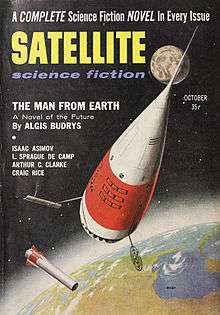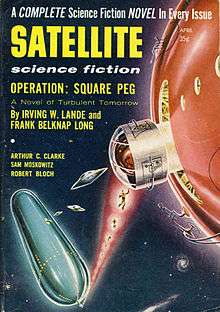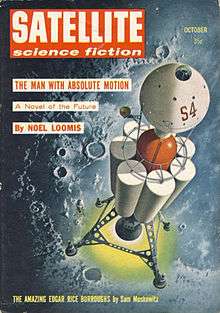Satellite Science Fiction
 First issue, October 1956 cover | |
| Categories | Science fiction |
|---|---|
| First issue | October 1956 |
| Final issue | May 1959 |
| Language | English |
Satellite Science Fiction was an American digest-sized science fiction magazine, published from 1956 to 1959 by Renown Publishers. Though Satellite’s run was short lived, the magazine is notable for introducing British science fiction novels to the American reading public.
Background
In 1936, Leo Margulies hired Mort Weisinger to work with him on Standard Magazines’s newly acquired Wonder Stories, a title that was soon after changed to Thrilling Wonder Stories (TWS). Though TWS published many canonical works of science fiction, the length of its content was rather limited. In 1939, Startling Stories was created as a companion to TWS, intended to showcase longer works of science fiction. Startling became a platform for novelists working in the genre, a trend that continued up until the magazine folded in 1955.
In 1956, Margulies broke away from established publishers to form his own company, Renown Publications. Enlisting his long-time partner Sam Merwin as the initial editor, Margulies created Satellite Science Fiction with an express purpose in mind: to compete with the emerging paperback market.[1] Because paperback science fiction novels, especially those issued by Ace Books, were “luring away potential magazine readers,” Margulies revived the editorial policy of Startling Stories, including “a complete novel in every issue” of Satellite.[2] If only for a brief time, Margulies’s found a way to lure readers back to the serial format.
Though Satellite employed the same gimmick as Startling, it was distinguished from its predecessor by being one of the only digest-sized magazines to exclusively feature novels.[3] And more importantly, Satellite departed from Startling’s rather limited definition of the science fiction “novel.” Whereas novels featured in Startling were frequently capped at 15,000 words, Margulies and Satellite expanded the pulp definition of the form to include works around the 40,000 word mark.[4]
Publication history and content
Satellite had a cover price of 35 cents, and with an average total of 53,000 words per issue, Satellite’s inclusion of complete novels “left precious little room for short stories” and editorial content.[5] As a result, many of Satellite’s short stories—frequently written by Isaac Asimov, Arthur C. Clarke, or Dal Stivens—revolved around “a clever idea or joke punch-line,” and Margulies did not include a letter column, one feature common to most pulp magazines.[6]
Much interior artwork was uncredited, but Leo Morey was a frequent contributor. In addition to the novels published in Satellite, a series of essays submitted to the magazine by Sam Moskowitz on the history of science fiction became the basis for his book Explorers of the Infinite, which examines the biographies of foundational science fiction authors.
Peter Nicholls and John Clute note that Satellite had a promising start.[7] The first two issues, edited by Sam Merwin, published “The Man from Earth” by Algis Budrys and Philip K. Dick’s debut novel, “A Glass of Darkness” (later expanded and retitled The Cosmic Puppets). The December 1957 issue also featured Jack Vance’s The Languages of Pao, which remains the only novel published in Satellite to remain regularly in print.[8] Leo Margulies edited the next three issues, eventually ceding the position to Cylvia Kleinman in August 1957.
But after fourteen rather successful printings, Margulies made a series of decisions in 1959 that spelled the end for Satellite. Seeking to make the magazine “more prominent on the newsstand,” Margulies began binding Satellite in the more common bedsheet size, switched to a monthly publication cycle, and sought out short stories in lieu of longer works.[9] These changes aligned Satellite with other pulp magazines of the time, but sacrificed the qualities that had made Satellite stand out from its competition. “Once the sales records for the first monthly issue came in, Margulies could see his mistake. Rather than gamble by returning to a digest format, he promptly axed the magazine.”[10] The final issue was published in May 1959.
Various covers




Notes
- ↑ Tymn, Marshall B.; Ashley, Mike (1985). Science Fiction, Fantasy, and Weird Fiction Magazines. Westport, Conn.: Greenwood Press. p. 493. ISBN 031321221X.
- ↑ Clute, John; Nicholls, Peter (1999). The Encyclopedia of Science Fiction (Rev. and enl. ed.). London: Orbit. p. 1049. ISBN 9781857238976.
- ↑ Tymn and Ashley 1985, p. 493.
- ↑ Tymn and Ashley 1985, p. 493.
- ↑ Tymn and Ashley 1985, p. 495.
- ↑ Tymn and Ashley 1985, p. 495.
- ↑ Clute and Nicholls 1999, p. 1049.
- ↑ Tymn and Ashley 1985, p. 495.
- ↑ Tymn and Ashley 1985, p. 496.
- ↑ Tymn and Ashley 1985, p. 496.
References
- Tymn, Marshall; Ashley, Mike (1985). Science Fiction, Fantasy, and Weird Fiction Magazines. Greenwood Press.
- Clute, John; Nicholls, Peter (1999). The Encyclopedia of Science Fiction. Orbit.
External links
| Wikimedia Commons has media related to Satellite Science Fiction. |